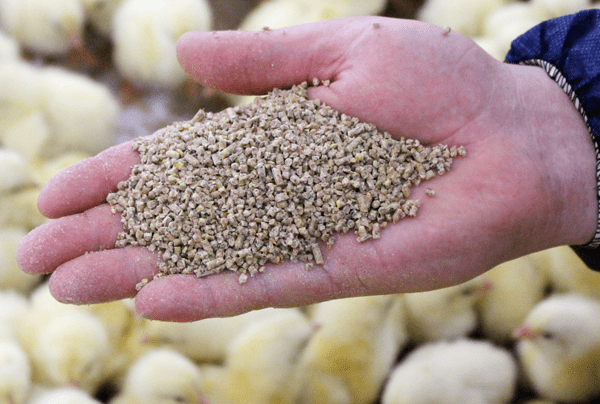

However, feed is the single most significant cost-incurring aspect of poultry production, accounting for nearly 60-70% of the total production cost. India’s climactic conditions, erratic monsoon, volatility in commodity markets, export obligations, and rising inflation pose mighty challenges to procuring quality raw materials at affordable prices to produce poultry feed. Feeding chickens is no joke.
To ascertain the protein and nutrient requirements of a growing population increasingly dependent on poultry products, implementing a sound feed strategy to ensure quality in poultry production is the need of the hour. Let’s dive into the current trends in the Indian poultry feed industry and probe the steps taken towards optimising and improving the obtainability of feed.
Steps Taken to Optimise Poultry Feed Production
- Process Optimisation in Poultry Feed Mill
A simple way to suffice the rise in demand for poultry feed is to optimize the efficiency of the existing feed, i.e., enhance productivity. Feed comprises 5 crucial stages: procuring ingredients (Monitoring the availability and pricing of required raw materials Check raw material while receiving and during storage, Sampling, Physical & Chemical check of ingredients, Protein & fat% check in soya, Carbohydrate, Fat & protein percent check in maize, check for adulteration etc.),grinding, blending, pelleting, and storage. But, the quintessential part of the manufacturing process is the pellet stage. Pelleting is converting fine mash feed into free-flowing, dense capsules. However, massive feed pellet manipulation exists during storage, transfer, and transportation. Hence, the number of pellets reaching the feeding sites is significantly lower than optimum.
Multiple factors affect pellet quality, like grinding, mixing, conditioning, and techniques. A sound way to improve feed efficiency and productivity is to enhance the Pellet Durability Index (PDI) by using an ideal combination of raw materials and implementing different machinery settings.
What Can Be Done?
- Optimize the crushing process to achieve uniformity. Opt for roller mills instead of hammer mills in crushing. The former produces more uniform-sized particles and a homogenous ingredients mixture.
- The steam conditioning system, usually the ranging from 80 to 85 degree celsius,must be fine-tuned to achieve adequate moisture content in the mash.(proper conditioning plays important role in the selection of the die)
- Select the appropriate die specification, such as the closed-hole pattern. It comprises 25% more die-holes than the standard pattern and increases pellet quality. (A. Amin & Nahed Sobhi, 19th June 2023, “Process Optimisation in Poultry Feed”)
- Prevent post-pelleting heat damage with an efficient cooling system and maintain the ideal temperature (After leaving the pellet mill, the temperature of pellets ranges between 70-90o Efficient cooling is requiring to reduce this temperature to 8oC above ambient temperature (Zimonja et al., 2007), along with reducing moisture from 15 to 17 percent down to 10 to 12 percent using a stream of ambient air (Robinson, 1976).The ambient temperatureis the temperature of the surrounding air. It can vary depending on the location and time of the year).
- Monitor production parameters like pellet mill load, motor amperage, and feed rate (In most cases for producing large quantity of feed the feed manufacturers increases the rate of feed process which results ultimately in lower pellet quality).
- Raw materials grinding should result in correct/uniformparticle size, and premium quality materials should be used.
- Integration of Technology in Feed
Optimizing feed production involves carefully breaking down the feed manufacturing process and analyzing and identifying the scope of improvement. The ideal goal is to reduce nutrient volatility in finished feed without affecting cost and quality. From batching and grinding to pelletization, automation can change the game in assessing feed quality and maintaining nutrition.
Amidst strife competition and feed comprising nearly 70% of operating costs, high-performing precision feed is necessary. To bolster feed production in these changing times, reliance on data and technology can save the day.
What Can Be Done?
- Automated ingredient measurement: Automation permits precise weighing and management of ingredients. It minimizes the manual load and reduces errors.
- Data analysis can accurately study the nutritional contents of raw materials, ingredient availability, and potency to maximize feed formulation efficiency.
- Remote and real-time monitoring is possible with sensors and the Internet of Things (IoT). Machinery checks and tracking equipment performance can save costs and result in preventive preservation.
- Use RFID to tag, track, and manage inventory. It reduces the error margin to a great extent and provides accurate ingredient availability.
- Pellet automation reduces variability while enhancing energy consumption.
- The importance of RnD
Accentuating poultry feed production stands on a robust barometer of research and development. It is one such sector constantly backed by innovation and enhancing the formulation to achieve desirable FCR, eggshell strength, and increased egg production. Thus, RnD is the key to premium animal nutrition. Today, the poultry industry has transformed from a mere backyard activity to a full-fledged commercial operation, and there is a growing demand for scientific, research-backed products.
The industry has witnessed a staggering increase in Soybean and Maize prices, creating an alarming situation for poultry farmers. While the raw material prices were surging, the market rates for eggs and meat were unfavorable, posing a challenging situation for the entire industry. These situations require immediate attention to alternatives to commonly used raw materials. Let’s look at how dedicated RnD has many benefits for feed production.
What Can Be Done?
- Optimise Nutrition Availability – With focused research, enhanced feed formulation can improve poultry health, gut, and growth.
- Ingredient Discovery – Research can lead to the discovery of novel ingredients that have better nutrition matrices and are cost-effective. It reduces the dependency on Soybean and Maize.
- Alternative Protein Sources – Apart from fish and bone meal, various other sources can meet the protein requirements of poultry without affecting protein digestibility.
- Sustainability- Imbibing greener practices by switching to eco-friendly ways of developing feed and using raw materials with a lesser carbon footprint.
- Feed processing techniques – Research is the key to developing technologies that improve pellet quality and nutrient bioavailability.
- Sustainable and Organic Feed formulation
Sustainability is the buzzword of the decade. Today, feed production must be economically viable and environmentally and socially conscious. Transforming feed into supreme quality poultry protein sustainably requires understanding nutrient metabolism, determining feed ingredients’ nutrient content and availability, and establishing a nutrient equilibrium.
In poultry production, where feed entails the majority of production cost, feed wastage due to disease, poor bio-security, and poor feed digestibility, among other reasons, results in poor feed digestion. It generates massive economic losses since the bird receives sub-optimal nutrition, resulting in higher FCR or high egg breakage. Feed wastage also results in increasing the nitrogen level in the environment. Thus, sustainability and organic feed formulations can positively impact feed production.
What Can Be Done?
- Raw material Sourcing – Responsibly source ingredients with minimal carbon footprint and less environmental impact.
- Circular economy – Recycle, repurpose, and reuse materials and by-products whenever possible. Create a closed-loop mechanism for nutrient utilization.
- Tailored feed formulations – Veterinarians and nutritionists are constantly altering feed formulations per the poultry breed and using them to meet their genetic requirements. It reduces unnecessary feed wastage.
- Waste Management – Utilising poultry waste as fertilizer or biofuel generation will minimize the environmental impact.
- Disease Mitigation in Feed
The disease poses a major challenge in producing feed. Often, the quality of raw materials is subpar, leading to anti-nutritional components that can severely affect the gut health of poultry. If preventive measures are overlooked, it can cause the death of an entire flock.
Moreover, seasonal factors are directly correlated to the susceptibility of poultry feed to diseases. For instance, during monsoons, the poultry feed can get infected with toxins. With specific feed additives, the disease can be prevented and cured. A sound feed formulation strategy can nullify the detrimental effects of disease and infection in feed. Look at the probable diseases impacting poultry feed and their combat mechanism.
What Can Be Done?
- Salmonella & coli Contamination – These bacteria can contaminate feed ingredients commonly seen in the poultry’s gut. A consortium of probiotics, organic acids, AGPs, and non-AGPs can limit the pathogenic load of these harmful bacteria.
- Mycotoxin Contamination – Fungal infections can contaminate the feed with mycotoxins i.e. aflatoxins, ochratoxins, trichothecenes, fumonisins, and zearalenone, which hampers the production & health of poultry. Use of toxin binders or detoxifiers in poultry feed can prevent the harmful effects of mycotoxins.
- Fat Utilisation- Emulsifiers can improve the digestibility of fat & fat-soluble nutrients, promote enhanced absorption, and better utilization of dietary energy. It also boosts uniform nutrient distribution.
How Can We Help?
For a poultry farmer, feed plays a central role in deciding the successful performance of their flock. Since it constitutes the majority of production costs, constructive importance should be given to improving feed productivity and efficiency. In a country like India, multiple factors can impact feed quality, from procurement, raw materials, and disease load to climactic conditions. However, careful inspection, preventive measures, focused RnD, sustainable practices, and reliance on technology can be a game changers for this industry.
As a rule of thumb, poultry production naturally is receptive to disease challenges. With preventive measures, accurate poultry management, and advanced and reliable animal nutrition solutions, poultry farmers can ensure the health and productivity of their flocks, leading to a thriving and sustainable industry.













